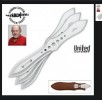The "strength" comes with time and practice. The more you throw, the stronger you get. The more you practice, the more skill you develop. Learn to crawl before you run, grasshopper.

You want suggestions, I've got opinions and facts. The Gil Hibben Competition throwers are 12-1/8" long and weigh in at 11.3 ounces. I have a set or two of Gil Hibbens lying on a shelf somewhere.
On large vs small knives - small knives bounce back at the thrower more on mis-throws than do larger/heavier knives. I prefer to observe the knife hit, not be worrying about dodging flying steel. This is the reason COMPETITION ROTATIONAL throwing, be it IKTHOF or AKTA or Mountain Man have a recommended knife length/ weight of minimum 12" long and 12 ounces (3/4#) or "an ounce to the inch". Both have a MAXIMUM of 16 inches for length and no maximum for weight.
I believe that the MINIMUM REQUIRED length and weight for NO-SPIN throwing to be 10 inches and either 9 or 10 ounces. Some folks are no calling no-spin "anti-spin", which sounds kinda stupid to me.
My competition knives (11 sets) range from 12.1 inches / 12-1/4 ounces for my no-spin knives up to 15.8 inches / 19.5 ounces for my rotational and mountain man knives.
In my experience of throwing for 20+ years, over time, larger knives are easier to throw and easier to stick consistently. The higher weight imparts more inertia on impact, so the points drive in deeper than a lighter knife will, making it more likely that the knife stays in the target - important for scoring. If it doesn't stick, it doesn't count."
Larger knives are easier to observe when they hit the target so that the thrower can more readily determine whether the knife is hitting point up or point down - important in determining if the thrower needs to move a little closer or a little further away from the target to achieve the desired number of rotations in the throw (1/2, 1, 1-1/2, 2, 2-1/2, 3 etc)
Larger knives, with more mass tend to bend rather than snap over time with "bad throws". Bends can be straightened, Snaps can't be fixed (reliably).
I also tend to prefer non-stainless steel knives. There are some out there who claim SS knives break more than non-stainless steel knives. I think it has more to do with poor heat treatment that the steel composition/formula. I just prefer non-stainless because knives made of non-stainless steel TEND to be cheaper than those made of SS.
Throwing knives should be in the 49 to 53 Rc hardness range, 54 to 56 is getting iffy and anything over that is way nore likely to snap on you that the lower ranges. Yes, lower hardness knives tend to bend more than the higher hardness knives, but I have NEVER EVER had a low hardness knife snap. Might have bent it, but a stomp or two and ots back to straight. Snap a knife and you have 2 small paperweights. And lower Rc knives can have any dings filed out more easily.
Those are my opinions on throwing knife lengths/weights/hardness. They're worth what you paid for them. More opinions on other topics available at the same rate.


